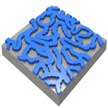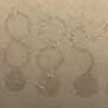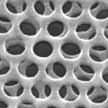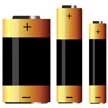Showing Spotlights 881 - 888 of 2878 in category All (newest first):
 Quasi-periodic and random patterns in nature can exhibit extraordinary functions, such as iridescent color in bird wings, strong adhesion in gecko feet, and water repellency from lotus leaves. However, nature-inspired 3D nanostructures can be prohibitively expensive to make using modern nanoscale manufacturing processes. In new work, researchers a design approach integrated with scalable nanomanufacturing that can rapidly optimize and fabricate quasi-random photonic nanostructures.
Quasi-periodic and random patterns in nature can exhibit extraordinary functions, such as iridescent color in bird wings, strong adhesion in gecko feet, and water repellency from lotus leaves. However, nature-inspired 3D nanostructures can be prohibitively expensive to make using modern nanoscale manufacturing processes. In new work, researchers a design approach integrated with scalable nanomanufacturing that can rapidly optimize and fabricate quasi-random photonic nanostructures.
Aug 1st, 2017
 Researchers have developed a stretchable and transparent graphene-based electronic tattoo (GET) sensor that is only hundreds of nanometers thick but demonstrates high electrical and mechanical performance. They show that a GET can be fabricated through a simple wet-transfer/dry-patterning process directly on tattoo paper, allowing it to be transferred on human skin exactly like a temporary tattoo, except this sensor is transparent. Due to its ultra-thinness, a GET can fully conform to the microscopic morphology of human skin via just van der Waals interactions and can follow arbitrary skin deformation without mechanical failure or delamination for an extended period of time.
Researchers have developed a stretchable and transparent graphene-based electronic tattoo (GET) sensor that is only hundreds of nanometers thick but demonstrates high electrical and mechanical performance. They show that a GET can be fabricated through a simple wet-transfer/dry-patterning process directly on tattoo paper, allowing it to be transferred on human skin exactly like a temporary tattoo, except this sensor is transparent. Due to its ultra-thinness, a GET can fully conform to the microscopic morphology of human skin via just van der Waals interactions and can follow arbitrary skin deformation without mechanical failure or delamination for an extended period of time.
Jul 31st, 2017
 Neural interfaces establish direct communication between the central nervous system (CNS) and a sovereign, man-made digital system. This technology is perhaps the most important advance in the study and treatment of the brain is the development of the neural interface. Nanotechnology fabrication methods can overcome the limitations of existing interface devices by producing electrodes with an extremely high surface to volume ratio, i.e., more probe units within the same volume, resulting in unprecedented specificity.
Neural interfaces establish direct communication between the central nervous system (CNS) and a sovereign, man-made digital system. This technology is perhaps the most important advance in the study and treatment of the brain is the development of the neural interface. Nanotechnology fabrication methods can overcome the limitations of existing interface devices by producing electrodes with an extremely high surface to volume ratio, i.e., more probe units within the same volume, resulting in unprecedented specificity.
Jul 26th, 2017
 Chiral metamaterials with strong chiroptical properties are an interesting new platform for optical signal modulation. Although plasmonic super chiral fields have been successfully applied to detect the chiral structures of proteins, it has remained challenging to detect the structural handedness of drug molecules due to their small size and thinner film adsorbed on the surface of metamaterials. Researchers now have reported a new type of plasmonic chiral metamaterial by stacking two layers of identical achiral gold nanohole arrays into moire patterns.
Chiral metamaterials with strong chiroptical properties are an interesting new platform for optical signal modulation. Although plasmonic super chiral fields have been successfully applied to detect the chiral structures of proteins, it has remained challenging to detect the structural handedness of drug molecules due to their small size and thinner film adsorbed on the surface of metamaterials. Researchers now have reported a new type of plasmonic chiral metamaterial by stacking two layers of identical achiral gold nanohole arrays into moire patterns.
Jul 25th, 2017
 Given the growing impact of nanotechnology on health care, pharmacy, and medicine, there is an increasing and urgent need for the development of reliable methods applicable to detect the biological contamination of nanoparticles. A new method offers a solution to the problems of the nanoparticle interference and correct quantification of bio-contaminants such as endotoxins. This proposed method is based on optical absorbance measurements.
Given the growing impact of nanotechnology on health care, pharmacy, and medicine, there is an increasing and urgent need for the development of reliable methods applicable to detect the biological contamination of nanoparticles. A new method offers a solution to the problems of the nanoparticle interference and correct quantification of bio-contaminants such as endotoxins. This proposed method is based on optical absorbance measurements.
Jul 24th, 2017
 Graphene currently is the most studied material on the planet - this is especially true for charge storage and the results from many laboratories confirm its potential to change today's energy-storage landscape. Specifically, graphene could present several new features for energy-storage devices, such as smaller capacitors, completely flexible and even rollable energy-storage devices, transparent batteries, and high-capacity and fast-charging devices.
Graphene currently is the most studied material on the planet - this is especially true for charge storage and the results from many laboratories confirm its potential to change today's energy-storage landscape. Specifically, graphene could present several new features for energy-storage devices, such as smaller capacitors, completely flexible and even rollable energy-storage devices, transparent batteries, and high-capacity and fast-charging devices.
Jul 20th, 2017
 Developing highly active electrocatalysts for photoelectrochemical water splitting is critical to bringing solar/electrical-to-hydrogen energy conversion processes into reality. Researchers have developed a novel 3D hierarchical hybrid electrocatalyst grown on electrochemically exfoliated graphene. The researchers then further integrated the hybrid nanosheets with a macroporous silicon photocathode, and the results show that it can enable highly active solar-driven photoelectrochemical water splitting in both basic media and real river water.
Developing highly active electrocatalysts for photoelectrochemical water splitting is critical to bringing solar/electrical-to-hydrogen energy conversion processes into reality. Researchers have developed a novel 3D hierarchical hybrid electrocatalyst grown on electrochemically exfoliated graphene. The researchers then further integrated the hybrid nanosheets with a macroporous silicon photocathode, and the results show that it can enable highly active solar-driven photoelectrochemical water splitting in both basic media and real river water.
Jul 20th, 2017
 Cutaneous fungal infections involving the skin, hair, or nails affect an estimated 25% of the world's population, and accounts for millions of outpatient visits. Currently, deep fungal infection require systemic therapy, which can pose a range of side effects or drug interactions depending on the clinical scenario. Investigators now have demonstrated the antifungal activity of nitric oxide generating nanoparticles against dermatophytes well known to cause invasive cutaneous infections.
Cutaneous fungal infections involving the skin, hair, or nails affect an estimated 25% of the world's population, and accounts for millions of outpatient visits. Currently, deep fungal infection require systemic therapy, which can pose a range of side effects or drug interactions depending on the clinical scenario. Investigators now have demonstrated the antifungal activity of nitric oxide generating nanoparticles against dermatophytes well known to cause invasive cutaneous infections.
Jul 19th, 2017
 Quasi-periodic and random patterns in nature can exhibit extraordinary functions, such as iridescent color in bird wings, strong adhesion in gecko feet, and water repellency from lotus leaves. However, nature-inspired 3D nanostructures can be prohibitively expensive to make using modern nanoscale manufacturing processes. In new work, researchers a design approach integrated with scalable nanomanufacturing that can rapidly optimize and fabricate quasi-random photonic nanostructures.
Quasi-periodic and random patterns in nature can exhibit extraordinary functions, such as iridescent color in bird wings, strong adhesion in gecko feet, and water repellency from lotus leaves. However, nature-inspired 3D nanostructures can be prohibitively expensive to make using modern nanoscale manufacturing processes. In new work, researchers a design approach integrated with scalable nanomanufacturing that can rapidly optimize and fabricate quasi-random photonic nanostructures.
 Subscribe to our Nanotechnology Spotlight feed
Subscribe to our Nanotechnology Spotlight feed





